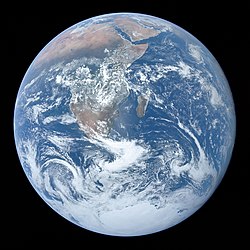Age of Earth
[7] Following the development of radiometric age-dating in the early 20th century, measurements of lead in uranium-rich minerals showed that some were in excess of a billion years old.
[14] His observations led him to formulate important stratigraphic concepts (i.e., the "law of superposition" and the "principle of original horizontality").
[17] In the mid-18th century, the naturalist Mikhail Lomonosov suggested that Earth had been created separately from, and several hundred thousand years before, the rest of the universe.
[18] Other naturalists used these hypotheses to construct a history of Earth, though their timelines were inexact as they did not know how long it took to lay down stratigraphic layers.
[19][20] He assumed that Earth had formed as a completely molten object, and determined the amount of time it would take for the near-surface temperature gradient to decrease to its present value.
His calculations did not account for heat produced via radioactive decay (a then unknown process) or, more significantly, convection inside Earth, which allows the temperature in the upper mantle to remain high much longer, maintaining a high thermal gradient in the crust much longer.
[23] According to modern biology, the total evolutionary history from the beginning of life to today has taken place since 3.5 to 3.8 billion years ago, the amount of time which passed since the last universal ancestor of all living organisms as shown by geological dating.
[24] In a lecture in 1869, Darwin's great advocate, Thomas Henry Huxley, attacked Thomson's calculations, suggesting they appeared precise in themselves but were based on faulty assumptions.
The physicist Hermann von Helmholtz (in 1856) and astronomer Simon Newcomb (in 1892) contributed their own calculations of 22 and 18 million years, respectively, to the debate: they independently calculated the amount of time it would take for the Sun to condense down to its current diameter and brightness from the nebula of gas and dust from which it was born.
In 1895 John Perry challenged Kelvin's figure on the basis of his assumptions on conductivity, and Oliver Heaviside entered the dialogue, considering it "a vehicle to display the ability of his operator method to solve problems of astonishing complexity.
This rate is given in terms of a "half-life", or the amount of time it takes half of a mass of that radioactive material to break down into its "decay product".
This suggested that it might be possible to measure the age of Earth by determining the relative proportions of radioactive materials in geological samples.
These "decay chains", such as the uranium-radium and thorium series, were known within a few years of the discovery of radioactivity and provided a basis for constructing techniques of radiometric dating.
Late in 1904, Rutherford took the first step toward radiometric dating by suggesting that the alpha particles released by radioactive decay could be trapped in a rocky material as helium atoms.
At the time, Rutherford was only guessing at the relationship between alpha particles and helium atoms, but he would prove the connection four years later.
Rutherford wrote of addressing a meeting of the Royal Institution in 1904: I came into the room, which was half dark, and presently spotted Lord Kelvin in the audience and realized that I was in trouble at the last part of my speech dealing with the age of the Earth, where my views conflicted with his.
To my relief, Kelvin fell fast asleep, but as I came to the important point, I saw the old bird sit up, open an eye, and cock a baleful glance at me!
[37]Rutherford assumed that the rate of decay of radium as determined by Ramsay and Soddy was accurate and that helium did not escape from the sample over time.
Boltwood did the legwork and by the end of 1905 had provided dates for 26 separate rock samples, ranging from 92 to 570 million years.
[citation needed] Holmes felt that they gave him tools to improve his techniques, and he plodded ahead with his research, publishing before and after the First World War.
Holmes published The Age of the Earth, an Introduction to Geological Ideas in 1927 in which he presented a range of 1.6 to 3.0 billion years.
Holmes, being one of the few people who was trained in radiometric dating techniques, was a committee member and in fact wrote most of the final report.
[40] Thus, Holmes' report concluded that radioactive dating was the only reliable means of pinning down a geologic time scale.
All of these processes may adversely affect isotopic dating mechanisms because the sample cannot always be assumed to have remained as a closed system, by which it is meant that either the parent or daughter nuclide (a species of atom characterised by the number of neutrons and protons an atom contains) or an intermediate daughter nuclide may have been partially removed from the sample, which will skew the resulting isotopic date.
This is important because the presence of the three mineral phases allows investigation of isotopic dates using samples that provide a great separation in concentrations between parent and daughter nuclides.
This 50 million year time span allows for accretion of the planets from the original solar dust and meteorites.
The Moon, as another extraterrestrial body that has not undergone plate tectonics and that has no atmosphere, provides quite precise age dates from the samples returned from the Apollo missions.
Lunar samples, since they have not been disturbed by weathering, plate tectonics or material moved by organisms, can also provide dating by direct electron microscope examination of cosmic ray tracks.
The accumulation of dislocations generated by high energy cosmic ray particle impacts provides another confirmation of the isotopic dates.





